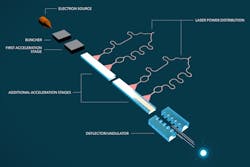Stanford-led team gets $13.5M Moore grant to develop working laser 'accelerator on a chip' prototype
The Gordon and Betty Moore Foundation has awarded $13.5 million to Stanford University (Palo Alto, CA) to lead a team of researchers (including from the U.S. Department of Energy’s SLAC National Accelerator Laboratory) to build a working particle accelerator the size of a shoebox based on laser "accelerator on a chip" technology.
In the technique, laser light propels electrons through a series of structured glass chips.
"Can we do for particle accelerators what the microchip industry did for computers?" said SLAC physicist Joel England, an investigator with the five-year project. "Making them much smaller and cheaper would democratize accelerators, potentially making them available to millions of people."
Uses for a compact accelerator would include research in biology and materials science and potential applications in security scanning, medical therapy and X-ray imaging, says Robert L. Byer, a Stanford professor of applied physics and co-principal investigator for the project who has been working on the idea for 40 years.
The international effort to make a working prototype of the chip-based accelerator was inspired by experiments led by scientists at SLAC and Stanford and, independently, at Friedrich-Alexander University Erlangen-Nuremberg (FAU) in Germany. Both teams demonstrated the potential for accelerating particles with lasers in papers published on the same day in 2013.
In the SLAC/Stanford experiments, published in Nature, electrons were first accelerated to nearly light speed in a SLAC accelerator test facility. At this point they were going about as fast as they can go, and any additional acceleration would boost their energy, not their speed.
The speeding electrons then entered a chip made of fused silica glass traveled through a microscopic tunnel with ridged walls. Laser light shining on the chip interacted with the ridges and produced an electrical field that boosted the energy of the passing electrons.
In the experiments, the chip achieved an acceleration gradient (energy boost over a given distance) roughly 10 times higher than the SLAC linear accelerator can provide. At full potential, this means the 2-mile-long linac could be replaced with a series of accelerator chips totaling 100 meters in length.
In a parallel approach, experiments led by Peter Hommelhoff of FAU and published in Physical Review Letters demonstrated that a laser could also be used to accelerate lower-energy electrons that had not first been boosted to nearly light speed. Both results taken together open the door to a compact particle accelerator.
The challenges of building the prototype accelerator are substantial, the scientists say. Demonstrating that a single chip works was an important step; now they must work out the optimal chip design and the best way to generate and steer electrons, distribute laser power among multiple chips, and make electron beams that are 1000 times smaller in diameter to go through the microscopic chip tunnels, among a host of other technical details.
SLAC and two other national laboratories—Deutsches Elektronen-Synchrotron (DESY) in Germany and Paul Scherrer Institute in Switzerland—will contribute expertise and make their facilities available for experiments. In addition to FAU, five other universities are involved in the effort: the University of California, Los Angeles, Purdue University, University of Hamburg, the Swiss Federal Institute of Technology in Lausanne (EPFL), and Technical University of Darmstadt.
Source: https://www6.slac.stanford.edu/news/2015-11-19-accelerator-on-a-chip-grant

John Wallace | Senior Technical Editor (1998-2022)
John Wallace was with Laser Focus World for nearly 25 years, retiring in late June 2022. He obtained a bachelor's degree in mechanical engineering and physics at Rutgers University and a master's in optical engineering at the University of Rochester. Before becoming an editor, John worked as an engineer at RCA, Exxon, Eastman Kodak, and GCA Corporation.
